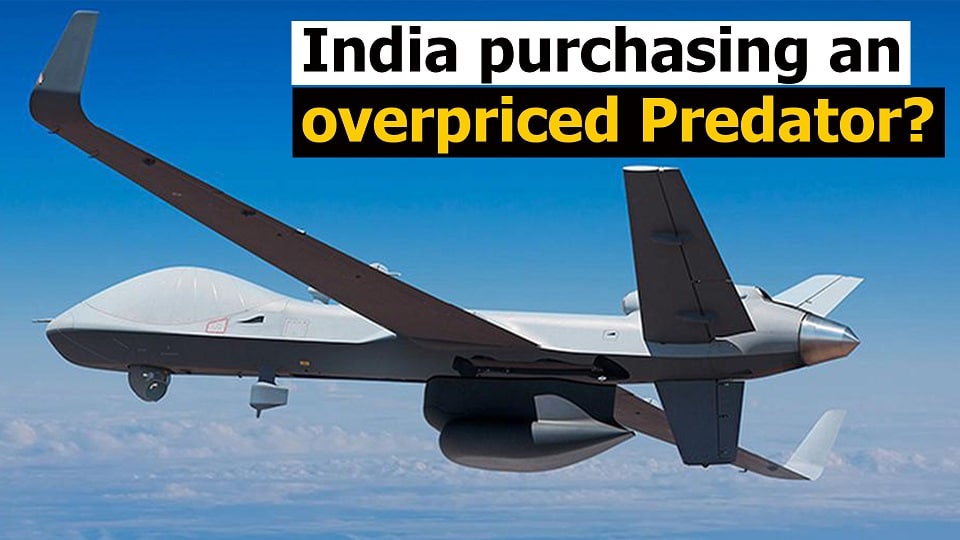Aerospace
Is India purchasing overpriced MQ-9B Predator Drones from the United States?

India acknowledges the purchase of a new unmanned aerial vehicle (UAV) for Indian Defence, which might be used to patrol borders and protect territory in emergency situations. According to a recent report, the Praedtor is being criticized for the excessive amount which India is planning to pay. We shall learn the rationale behind this UAV’s exorbitant cost in this video.
India is currently developing 5 UAVs that it plans to use in the future.(Opens in a new browser tab)
The characteristics of a UAV are similar to those of a fighter jet but without a pilot inside. Instead, it is entirely controlled from the ground using a satellite navigation system. Drones are used to identify ground reports from remote locations and to detect enemy activity using infrared cameras and other cutting-edge sensors.
India to buy 31 Predator drones from the US for $3.5 bn(Opens in a new browser tab)
The MQ 9B American drone marine guardian UAV can fly up to 40,000 feet and has a 30-hour endurance. The sea guardian has a maximum range of 5,000 nautical miles and an airspeed of 210 KTAS. Additionally, the exterior cargo capacity is 2,155 kg with 9 external hardpoints, while the interior payload capacity is 363 kg. Around 5,670 kg is the drone’s maximum takeoff weight.
India’s $3 Billion MQ-9 Reaper Drones Deal With US In Advanced Stage(Opens in a new browser tab)
Up to 31 of these drones will be purchased by India for the price of 99 million dollars each. Other nations have bought conventional drones of the same sort, which may cost up to 55 million dollars, but they are devoid of any sophisticated features.
Given that technology has improved and that more services might be required in the future, these drones are pricey. Indian UAVs could now operate more conveniently thanks to new technologies. Additionally, this would be equipped with Indian-made missiles and an aircraft system.
Engines, radar processor units, avionics, sensors, and software are just a few of the major parts and subsystems that will be made in or imported from India. The USA is willing to give away 15–20% of the technology transfer.
India’s military forces will be able to monitor the nation’s land and maritime borders thanks to these drones.
Two MQ-9B Sea Guardian drones were leased by the Indian Navy from General Atomics for a year to be used for surveillance in the Indian Ocean. After that, the lease’s term was extended.
Indian Defence may increase its reliance on external monitoring to better secure the country. These drones will be used near the border between Pakistan and China primarily for activity observation. The 30-hour endurance may serve as extra support for successful strategies.

Aerospace
When Ratan Tata was denied entry to the airfield at the Aero India show, he waited

During our visit to Aero India 2019, we had the unexpected opportunity to see Ratan Tata at the event, which was a thrilling moment for us. However, there was a surprising hiccup when the security staff didn’t allow him to enter due to a lack of a security pass.
Despite this, he remained calm and patiently waited for about 20 minutes until a member of the Tata team brought him the required pass, after which he calmly proceeded inside. It was a humbling sight, showcasing his composed demeanor even in such situations.
Ratan Tata ji is not only a renowned industrialist but also a trained pilot, holding a pilot’s license. In 2007, he became the first Indian civilian to fly the F-16 Falcon during the Aero India show in Bangalore—a proud moment for the nation.
His passion for aviation extended beyond flying, as he played a key role in shaping India’s aerospace industry. Under his leadership, Tata ventured into manufacturing and maintaining aerospace components while upholding its legacy of quality. Notably, Tata’s collaboration with Airbus to develop and manufacture the C295 aircraft is a testament to its growing influence in the sector.
-

 Aviation2 months ago
Aviation2 months agoMicrosoft Flight Simulator Raises $3 Million to Bring Back the An-225 Mriya
-

 Airlines2 months ago
Airlines2 months agoQantas Engineers Stage Walkout Over Cost of Living Concerns
-

 Airlines2 months ago
Airlines2 months agoQatar Citizens Can Travel to the United States Without a Visa
-

 Aviation2 months ago
Aviation2 months agoQatar Airways bans these new Electronic Devices on plane
-

 Airlines2 months ago
Airlines2 months agoJapan Airlines Rolls Out Free Domestic Flights to International Passengers
-

 Defence2 months ago
Defence2 months agoWhich Country Has the Largest Fleet of Fighter Aircraft?
-

 Airport2 months ago
Airport2 months agoWestern Sydney Airport Welcomes Its First Plane After 6 Years of construction
-

 Travel2 months ago
Travel2 months agoQatar Airways Launches Four Additional Flights from Amsterdam








